This page introduces the concept and precautions about diversified investment and portfolio.
By combining several financial assets (hereinafter referred to simply as assets), fluctuations in the total amount of assets can be reduced.
ref 1
The reason is simple: if you have some assets, the price fluctuations of each asset will be defferent.
Consider a specific example.
When a war breaks out in your own country, inflation can occur due to a shortage of supplies and the issuance of war bonds.
Some companies will go bankrupt, and you may lose your job.
Although it is more important to survive more than moneys in the first place,even if your assets in your country lose their value,
if you have foreign assets, you can increase your chance of survival by selling them and going over the emergency.
However, the crisis does not always occur in your own country.
You should also have assets in your own country in case of a crisis abroad.
Inflation rate may rise even in the absence of anomalous events such as war.
In such cases, it is possible to maintain the ability to purchase by holding inflation-resistant assets such as stocks.
On the contrary, in the case of deflation, bonds seem to be better than stocks.
This is an imaginary story, but such a story is historically common.
Therefore, many investors, regardless of nationality, have accepted the phrase "Don't put all eggs in one basket" and have invested by diversifying into several defferent assets.
As mentioned at the beginning, the effect of diversified investment is to reduce the price fluctuations in total assets.
To determine investing to which assets and at what ratio is called asset allocation, and the set of allocated assets is called a portfolio.
The basic idea of diversification is to have assets with different correlation coefficients together.
The more different the correlation coefficient, the price of each asset tend to change different direction, which lead to reduce the fluctuation of total portfolio.
Since stocks and bonds in the same country tend to show different correlation coefficients both domestically and overseas,
if all assets is divided to stocks and bonds and to domestic currency and foreign currency, the asset allocation will be as shown in Figure 1-3 (a).
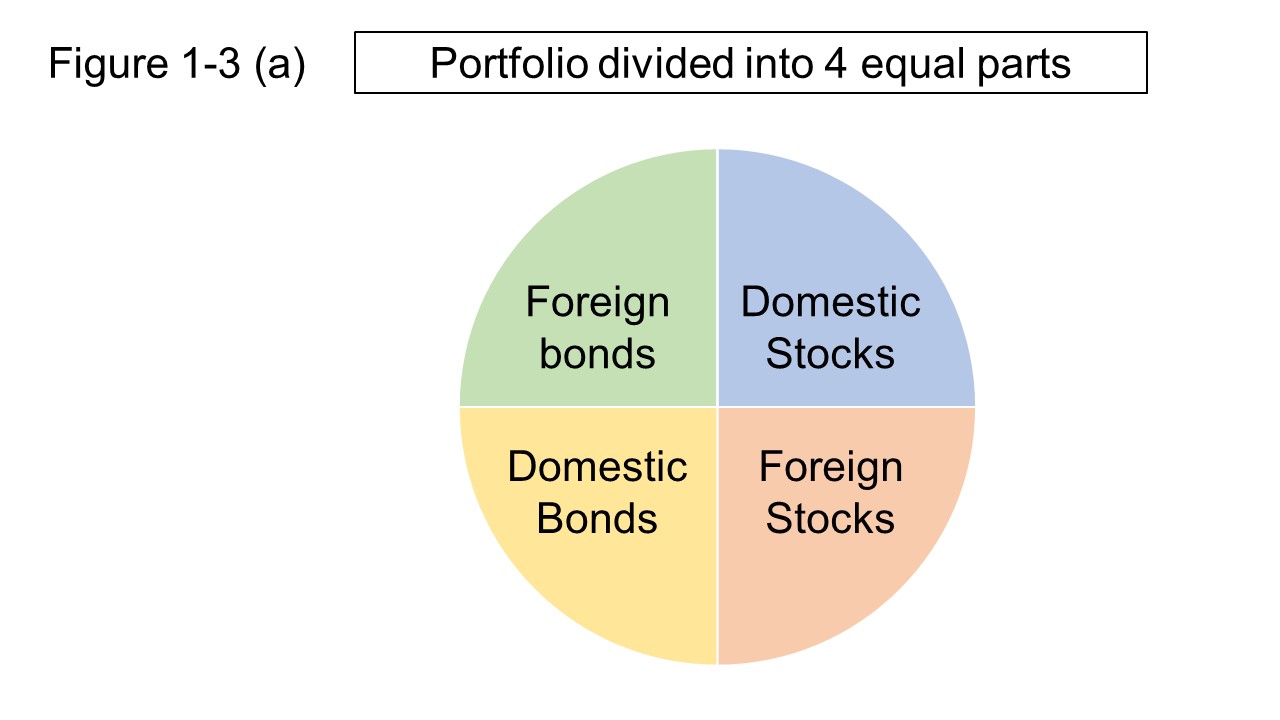
There are various other assets such as gold and REITs, but this website will focus on the four asset classes of domestic stocks, foreign stocks, domestic bonds, and foreign bonds, because this contents are for investment beginners.
In asset management, even if the target portfolio is set at a fixed ratio, that ratio usually changes as time goes on.
In addition, the asset ratio of the desired portfolio may change depending on the situation.
Therefore, it is often necessary to buy additional assets or buy or sell owned assets to get closer to the desired ratio of assets.
it is called rebalancing to return the first ratio, and called realocation to change the ratio of assets.
To return the first ratio is called rebalancing, and to change the ratio of assets is called reallocation.
It's good idea to divide total assets into four equal parts, but isn't there a better portfolio for the purpose of smaller changes the value of total assets?
By measuring data on price changes over a period of time, statistics such as expected rate of return and variance (or standard deviation) can be obtained from the data for any asset.
The variance of the rate of return obtained from this measurement indicates the risk (the degree of return uncertainty) of the asset.
Then, from the expected value and variance for the individual assets, a portfolio that minimizes the variance of total assets combined these is mathematically derived.
ref 2
The mechanism is as follows.
The expected rate of return and variance of a portfolio that combines individual assets can be expressed by mathematical formulas including variables of their ratio, based on the statistics of each asset.
In those formulas, setting a value as the expected rate of return of the portfolio gives the ratio that minimizes the variance for the expected rate of return.
The curve that is connected some points, which showed smallest standard deviation (positive square root of the variance) for an expected rate of return, is called the minimum variance frontier, and the part above the point where the standard deviation is the smallest is called the efficient frontier.
The reason for paying attention to the upper half of the curve is that it is desirable to show a higher expected rate of return for the same standard deviation.
An image of an efficient frontier is shown in Figure 1-3 (b).
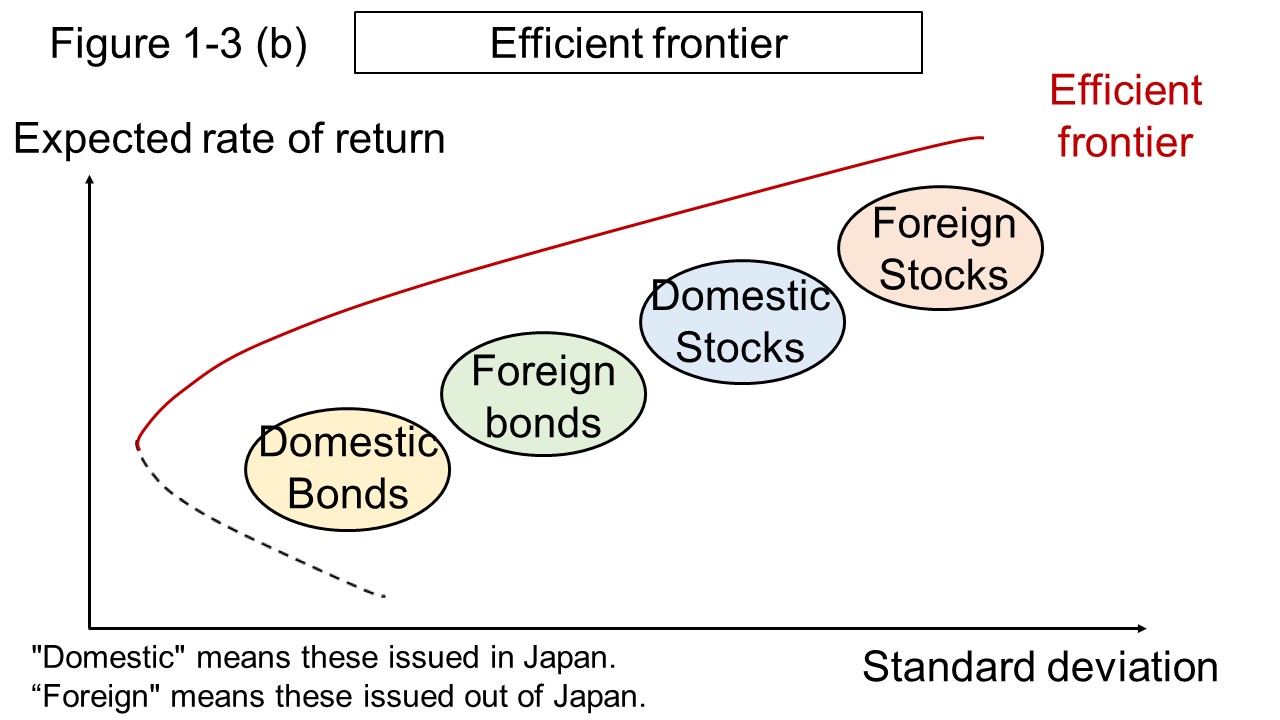
The efficient frontier is completed by the point which minimize the standard deviation of the portfolio to a certain expected rate of return.
Therefore, according to this idea, you can decide the portfolio with the lowest risk by how much you want to gain, and the portfolio with the highest expected rate of return by how much risk can be tolerated, as shown in Figure 1-3 (c).
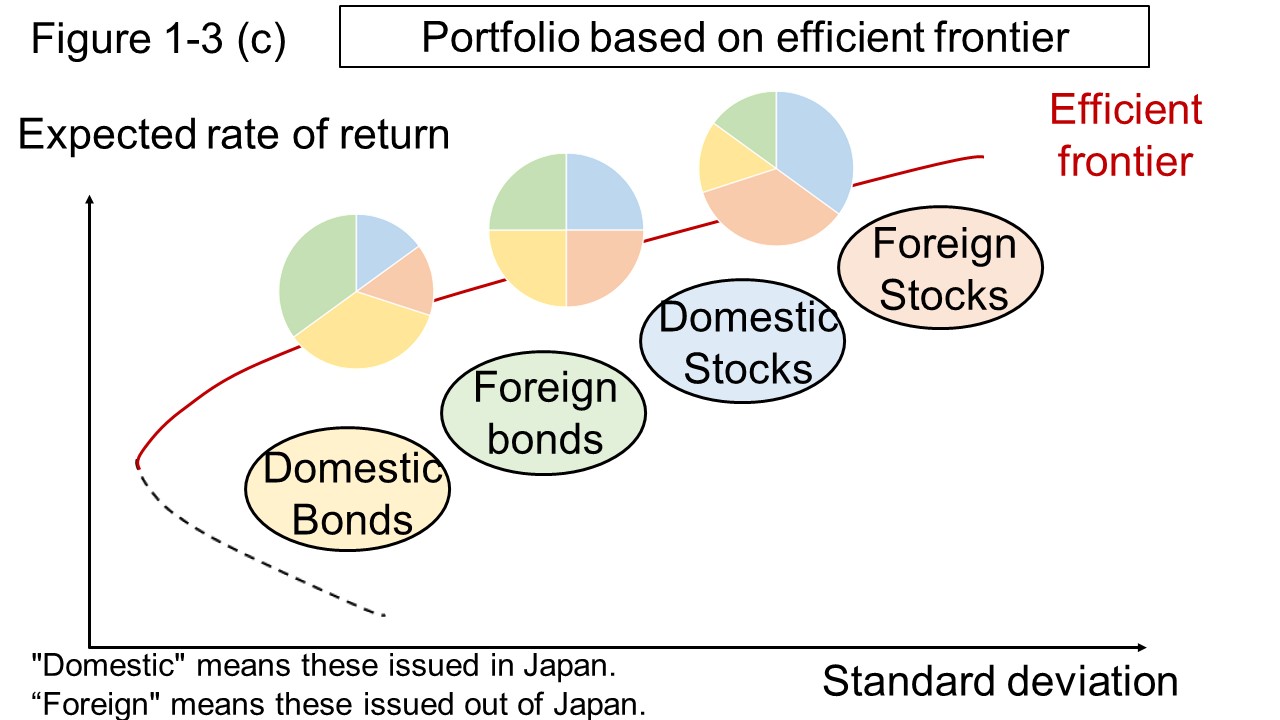
Note that, because this theory is based on past price cahges of individual assets, the period which the statistics of each asset have been measured will affect the optimal retio of asset.
Also, as a matter of course on the principle, the efficient frontier should be revised as new data comes out.
It should be understood that portfolios on the efficient frontier are based on historical data and do not guarantee future results.
As shown in the probability distribution of returns for each asset class in Figure 1-2 (b), the expected rate of return was positive for all of the above four assets.
On the other hand, among the assets that have not been dealt with so far, there is an asset that has historically showed a negative expected rate of return after adjusting for inflation.
It's cash (more exactly, dollars).
ref 3
But that doesn't mean that cash is useless as an asset.
Cash is necessary in daily life, and only cash usually able you to buy assets.
Therefore, consider a portfolio that includes cash.
Which is more stable as a whole if you invest 50% or 90% of your total assets in non-cash assets?
If the invested assets are 25% each for domestic stocks, foreign stocks, domestic bonds, and foreign bonds, the ratio of the total assets will be as shown in Figure 1-3 (d).
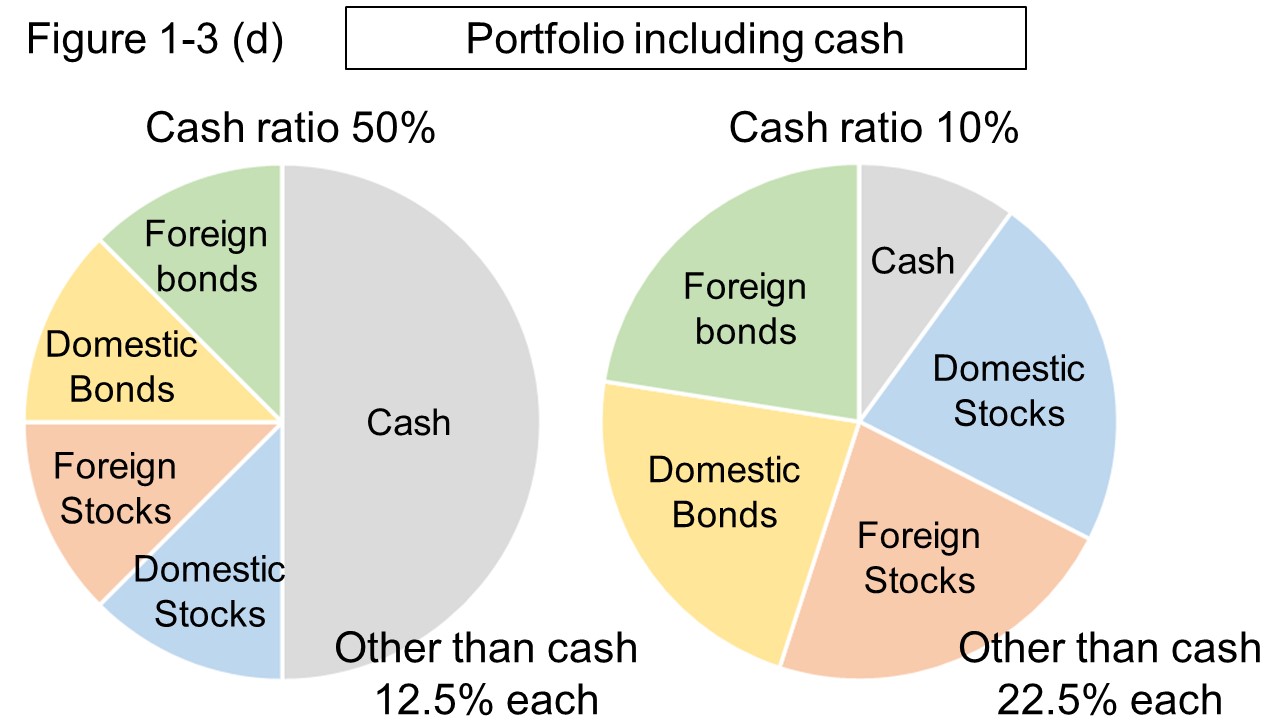
If cash is your home currency, in the figure, assets of the home country occupy 75% on the left, and 55% on the right.
Again, cash is an asset that can buy something but is vulnerable to inflation.
And all non-cash assets have historically showed a positive expected rate of return.
It is not necessary to fix the cash ratio, but if it is to be managed in the long term, you should think about the future portfolio including cash.
So far, althougu we have discussed about the portfolio of the total asset, diversified investment can also reduce changes in the value of individual asset classes.
This section outlines the diversified investment for stocks with large price fluctuations.
The reason why diversified investment in stocks can reduce changes in the total portfolio of stocks is difference in price fluctuations of each stock, as in the case of the total asset portfolio.
In a portfolio of stocks, price fluctuation tend to decrease as the number of stocks increases, but fluctuations (risks) itself cannot be eliminated no matter how many stocks are increased.
This risk of price fluctuations that always remains until the end is called systematic risk or market risk.
Simply, the degree of return fluctuation in the entire stock market (stock index) is the market risk.
Therefore, the risk of price fluctuations in stock investment can be considered by dividing them into systematic Risk caused by the entire stock market and Unsystematic Risk caused by stocks, as shown in Figure 1-3 (e).
The former is a risk that is not reduced by diversifing stocks, and the latter is a risk that is reduced by diversifying stocks.
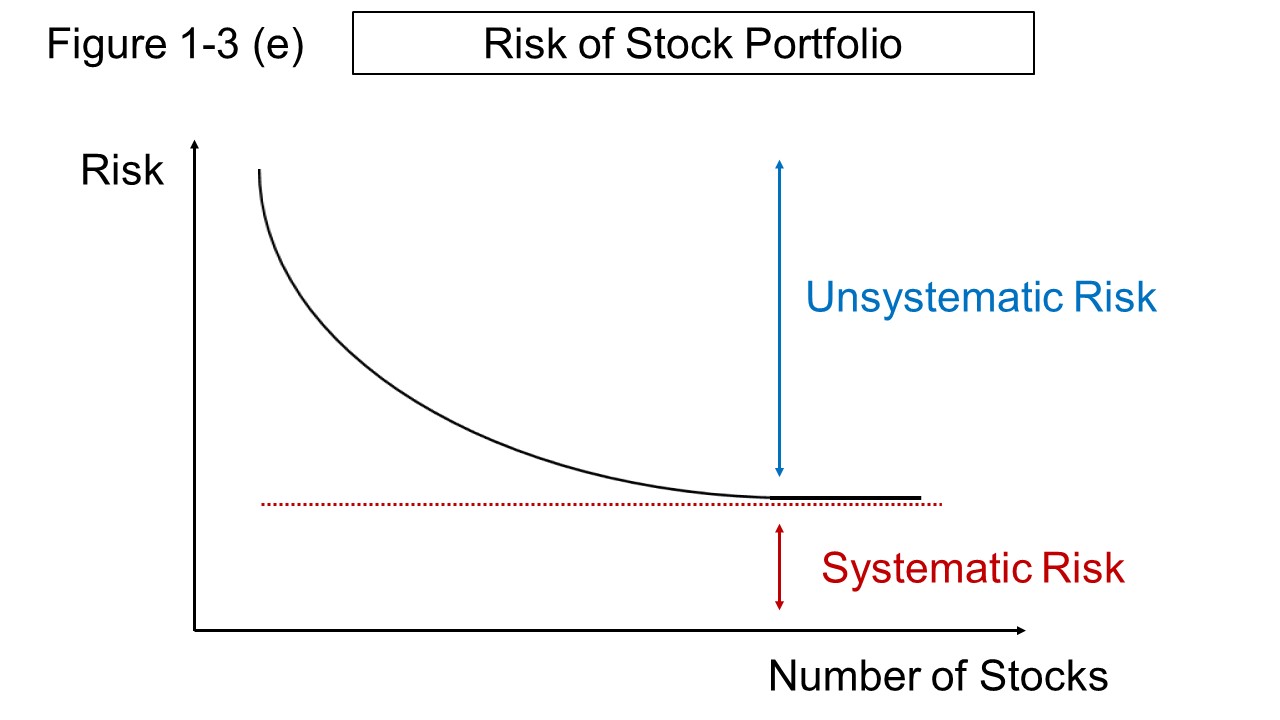
Systematic Risk does not disappear, but it is known that most of Unsystematic Risk can be reduced with about 20 different stocks.
Of cource, although negative correlation makes the fluctuation of the stock portfolio smaller, even when prices of some stocks show positive correlation, there is a certain risk reduction effect because the ratio of the change is different.
Therefore, when you add new stock to your portfolio, the effect of diversification can be arised simply by selecting from different business than the stocks owned.
In the first place, it should be noted that it is not always suitable to show negative correlation.
For example, the stock prices of the two stocks shown in Figure 1-3 (f) both show negative correlation.
But in the figure on the left, one of the stocks is on downtrend, while in the figure on the right, both stocks are on uptrend.
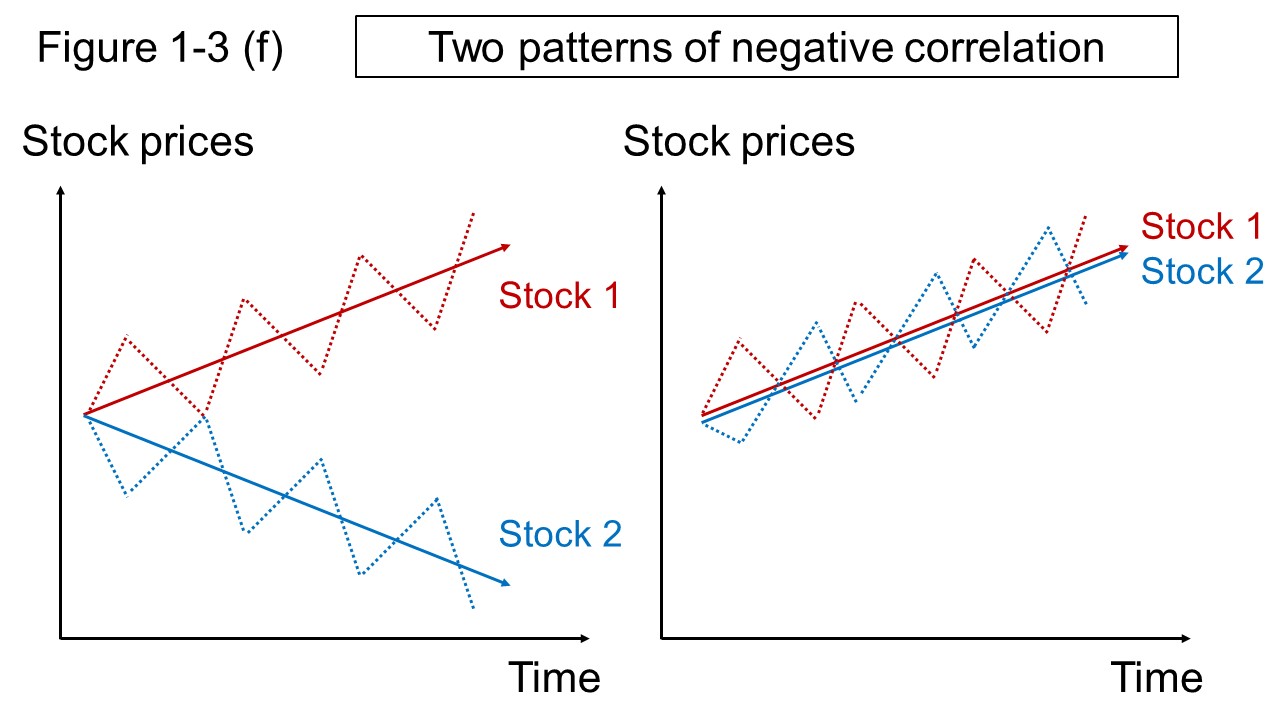
The reason it is better to diversify in stock investments is that the price fluctuations of individual stocks are much larger than the price fluctuations of the stock index.
High returns can be expected from stocks, but to minimize the losses until expectations are realized is just as important as returns.